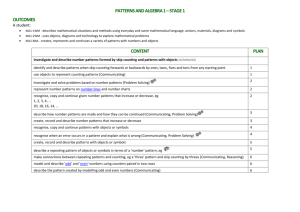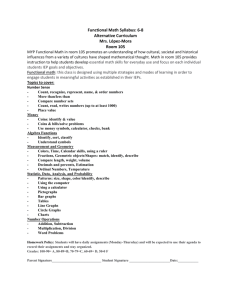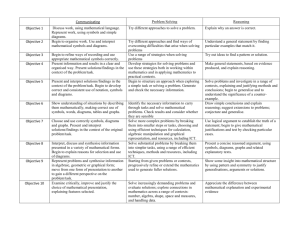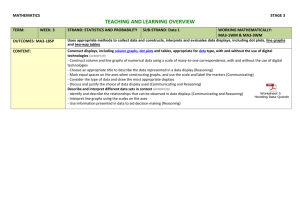data 1 - Glenmore Park Learning Alliance
advertisement
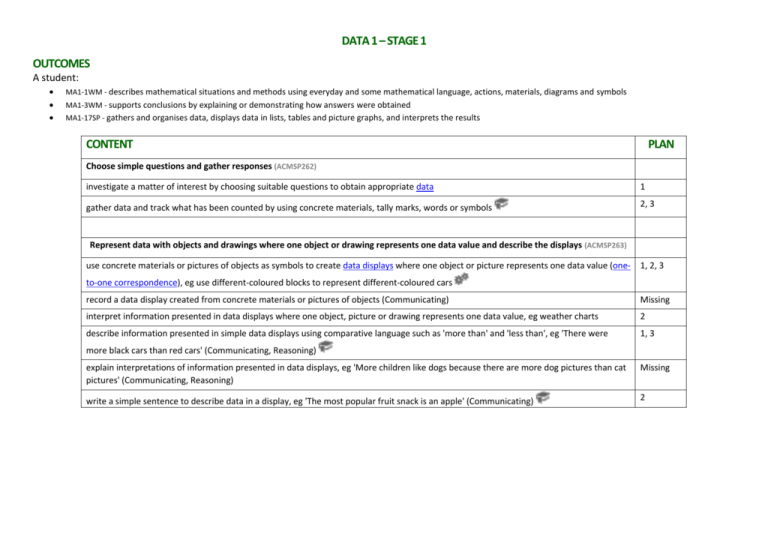
DATA 1 – STAGE 1 OUTCOMES A student: MA1-1WM - describes mathematical situations and methods using everyday and some mathematical language, actions, materials, diagrams and symbols MA1-3WM - supports conclusions by explaining or demonstrating how answers were obtained MA1-17SP - gathers and organises data, displays data in lists, tables and picture graphs, and interprets the results CONTENT PLAN Choose simple questions and gather responses (ACMSP262) investigate a matter of interest by choosing suitable questions to obtain appropriate data 1 gather data and track what has been counted by using concrete materials, tally marks, words or symbols 2, 3 Represent data with objects and drawings where one object or drawing represents one data value and describe the displays (ACMSP263) use concrete materials or pictures of objects as symbols to create data displays where one object or picture represents one data value (one- 1, 2, 3 to-one correspondence), eg use different-coloured blocks to represent different-coloured cars record a data display created from concrete materials or pictures of objects (Communicating) Missing interpret information presented in data displays where one object, picture or drawing represents one data value, eg weather charts 2 describe information presented in simple data displays using comparative language such as 'more than' and 'less than', eg 'There were 1, 3 more black cars than red cars' (Communicating, Reasoning) explain interpretations of information presented in data displays, eg 'More children like dogs because there are more dog pictures than cat pictures' (Communicating, Reasoning) Missing write a simple sentence to describe data in a display, eg 'The most popular fruit snack is an apple' (Communicating) 2 DATA 2 – STAGE 1 OUTCOMES A student: MA1-1WM - describes mathematical situations and methods using everyday and some mathematical language, actions, materials, diagrams and symbols MA1-2WM - uses objects, diagrams and technology to explore mathematical problems MA1-3WM - supports conclusions by explaining or demonstrating how answers were obtained MA1-17SP - gathers and organises data, displays data in lists, tables and picture graphs, and interprets the results CONTENT PLAN Identify a question of interest based on one categorical variable and gather data relevant to the question (ACMSP048) pose suitable questions that will elicit categorical answers and gather the data, eg 'Which school sport is the most popular with our class 4, 5 members?', 'How did each student in our class get to school today?' predict the likely responses within data to be collected (Reasoning) 6 determine what data to gather in order to investigate a question of interest, eg colour, mode of transport, gender, type of animal, sport 6 (Problem Solving) Collect, check and classify data (ACMSP049) collect data on familiar topics through questioning, eg 'How many students are in our class each day this week?' 4, 5 use tally marks to assist with data collection (Communicating) 4, 5, 6 identify categories of data and use them to sort data, eg sort data collected on attendance by day of the week and into boys and girls 4, 5 present Create displays of data using lists, tables and picture graphs and interpret them (ACMSP050) represent data in a picture graph using a baseline, equal spacing, same-sized symbols and a key indicating one-to-one correspondence 4 identify misleading representations of data in a picture graph, eg where the symbol used to represent one item is shown in different sizes 4 or where symbols are not equally spaced (Reasoning) use digital technologies to create picture graphs (Communicating) 4 display data using lists and tables 4, 5 use displays to communicate information gathered in other learning areas, eg data gathered in a unit on families or local places 5 (Communicating) interpret information presented in lists, tables and picture graphs 4, 5 describe data displayed in simple tables and picture graphs found in books and created by other students (Communicating) 6 record observations based on tables and picture graphs developed from collected data 6
